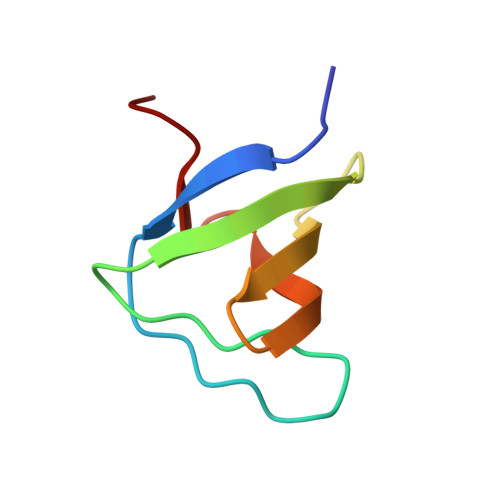Specificity determinants of a novel Nck interaction with the juxtamembrane domain of the epidermal growth factor receptor.
Hake, M.J., Choowongkomon, K., Kostenko, O., Carlin, C.R., Sonnichsen, F.D.(2008) Biochemistry 47: 3096-3108
- PubMed: 18269246
- DOI: https://doi.org/10.1021/bi701549a
- Primary Citation of Related Structures:
2JS0, 2JS2 - PubMed Abstract:
Nck is a ubiquitously expressed adaptor protein containing Src homology 2 (SH2) and Src homology 3 (SH3) domains. It integrates downstream effector proteins with cell membrane receptors, such as the epidermal growth factor receptor (EGFR). EGFR plays a critical role in cellular proliferation and differentiation. The 45-residue juxtamembrane domain of EGFR (JM), located between the transmembrane and kinase domains, regulates receptor activation and trafficking to the basolateral membrane of polarized epithelia through a proline-rich motif that resembles a consensus SH3 domain binding site. We demonstrate here that the JM region can bind to Nck, showing a notable binding preference for the second SH3 domain. To elucidate the structural determinants for this interaction, we have determined the NMR solution structures of both the first and second Nck SH3 domains (Nck1-1 and Nck1-2). These domains adopt a canonical SH3 beta-barrel-like fold, containing five antiparallel strands separated by three loop regions and one 3 10-helical turn. Chemical shift perturbation studies have identified the residues that form the binding cleft of Nck1-2, which are primarily located in the RT and n-Src loops. JM binds to Nck1-2 with an affinity of approximately 80 microM through a positively charged sequence near the N-terminus, as opposed to the polyproline sequence. The two Nck SH3 domains exhibit both steric and electrostatic differences in their RT-Src and n-Src loops, and a model of the Nck1-2 domain complexed with the JM highlights the factors that define the putative binding mode for this ligand.
Organizational Affiliation:
Department of Biochemistry, Case Western Reserve University, Cleveland, Ohio 44106, USA.














